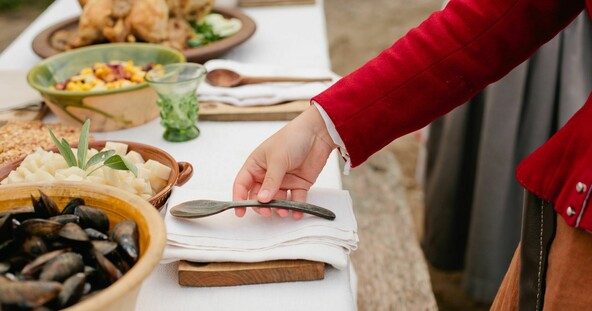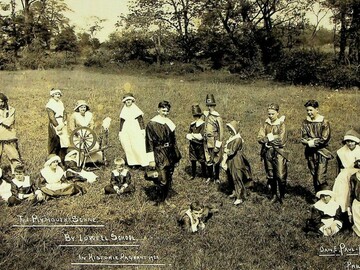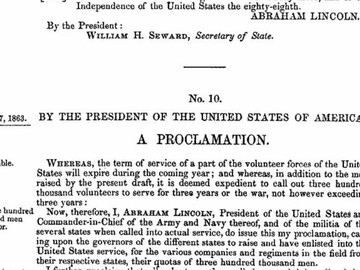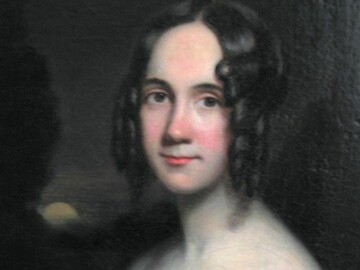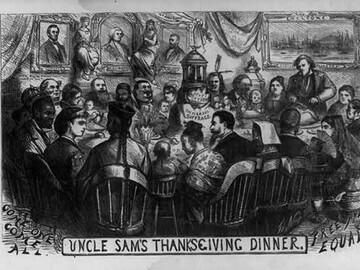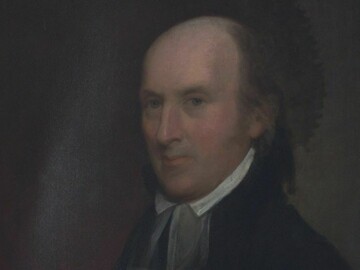Unit 5: Summary
This Unit supports Activities 1-4 in the "You are the Historian" Interactive Game.
Learning Themes:Americans have long thought the history of the American holiday Thanksgiving to be relatively simple. The actual story of how the story of “the First Thanksgiving” was written and retold and how the holiday was developed and embraced by a nation is surprisingly complex. In many respects, the growth of the distinctly American holiday and the myth associated with it parallels (and continues to parallel) the development of the nation itself. In this unit, students will explore how the 1621 harvest feast came to be known as the First Thanksgiving, the country’s protean holiday, and how the meaning of the holiday changes as new meaning is layered.
Key Ideas
- There are innumerable ways to “give thanks” and celebrate thanksgivings. The idea of giving thanks and communing with friends and family is cross-cultural and centuries old. Though there are many traditions associated with Thanksgiving, many families have their own unique traditions as well.
- The American holiday of Thanksgiving means different things to different people. It is multi-layered and each generation adds its own meanings, understandings, and traditions to holiday. Some meanings and traditions reflect individual families or communities or the state of the nation at that time, such as the arrival of new immigrants, the outbreak of World War II, or the Civil Rights Movement.
- Thanksgiving as an American holiday evolved over time. In the 19th century, advocates such as Sarah Josepha Hale linked the 1621 harvest celebration, the Pilgrims, and the Wampanoag with a long-standing New England harvest tradition making them the founders of the holiday in generations of popular imagination. She used the media to popularize the connections in Godey’s Lady’s Book, the magazine she edited for many years.
- For many Wampanoag people, Thanksgiving is a day of mourning. Some choose to spend the day honoring those who came before them and the challenges they endured with fasts, songs, and spending time with family and friends. Others choose to speak out about challenges still facing Indigenous people today.
Learning Goals
In this unit, students will:
- Give example of how information and experiences may be interpreted differently by people from different cultural groups
- Demonstrate how holding different values and beliefs can contribute or pose obstacles to understanding between people and groups
- Identify examples of continuity and change as depicted in stories, photographs, and documents
- Compare and Contrast differing stories or accounts about past events, people, places, or situations, and offer possible reasons for the difference
- Use sources to learn about the past in order to inform decisions about actions on issues of importance today
- Identify and describe examples of tensions between and among individuals, groups, and institutions
- Show how groups and institutions work to meet individual needs and promote or fail to promote the common good.
- Locate, access, organize, and apply information from multiple sources reflecting multiple points of view
- Evaluate positions about an issue based on the evidence and arguments provided and describe the pros, cons, and consequences of holding a specific position
- Examine the influence of citizens and officials on policy decisions.
Essential Questions
- How did the American tradition of celebrating the holiday of Thanksgiving begin?
- Why did Americans start telling the story of the “First Thanksgiving”? Why do some keep telling it?
- What is the past? How is “the past” different from “history?”
- What role do we have in creating history?
- How do historians use primary sources and educated guesses to research the past and create history?
- How can we celebrate Thanksgiving respectfully?
Suggested Activities
Grades K-5
- If your school hosts a holiday event or dinner, have the students present about the history of the harvest celebration of 1621 and the American holiday of Thanksgiving. Or, instead of a traditional Thanksgiving celebration, have a “giving thanks” celebration that celebrates and gives thanks for all cultures. Students could be encouraged to wear their own cultural dress and share their own traditions of thanksgiving.
- Oral history and storytelling is an important way of passing important information from generation to generation. Students can work in groups or individually to interview elders in their community about their thanksgiving traditions.
Grades 6-12
- Students work in groups to research a public monument in their town. What historical event does it commemorate? Whose voices or perspectives are missing from the history? As a group, students draft a new text for the monument and participate in a local monuments “tour.”
- Students work in groups or individuals to compare Wamsutta’s speech to other speeches by civils rights leaders and activists past and present.
- Students use the materials in the unit to design their own museum exhibit. Students can pick a theme, write an introduction for the exhibit, select the items to exhibit and write a label for each describing how it relates to their chosen theme. Students should think about what they want to public to know about their chosen theme as they design their exhibit. Students offer tours of their “museums” to other students groups, family members, or school faculty.
- Creative Prompt: What does thanksgiving mean to you today? Encourage students to use themselves and their communities as primary sources along with the available resources in this guide.
Additional resources
Curriculum Alignments
K.T1
What does it mean to be responsible?
K.T3
How do we commemorate our shared history as a nation and community?
K.T4
What kinds of work do women, men, and children do?
1.T1
What does it mean to belong to or lead a group?
3.T1
How can people get involved in government?
5.T1
To what extent was North America a land of opportunity, and for whom?
8.T4
What is the role of the individual in maintaining a healthy democracy?
USII.T4
How did the U.S. government respond to challenges to freedom at home during the Cold War?
Change, Continuity, and Context
- D2.His.1.K-2., D2.His.2.K-2., D2.His.3.K-2., D2.His.1.3-5., D2.His.2.3-5., D2.His.3.3-5.
- D2.His.1.K-2., D2.His.2.K-2., D2.His.3.K-2., D2.His.1.3-5., D2.His.2.3-5., D2.His.3.3-5.
Perspectives
- D2.His.4.K-2., D2.His.6.K-2., D2.His.4.3-5., D2.His.5.3-5., D2.His.6.3-5.
- D2.His.4.6-8., D2.His.5.6-8., D2.His.4.9-12., D2.His.5.9-12., D2.His.6.9-12., D2.His.7.9-12., D2.His.8.9-12
Applying Civic Virtues and Democratic Principles
- D2.Civ.10.3-5,
Historical Sources and Evidence
- D2.His.9.K-2., D2.His.10.K-2., D2.His.12.K-2., D2.His.9.3-5., D2.His.10.3-5., D2.His.12.3-5., D2.His.13.3-5.
- D2.His.10.6-8., D2.His.12.6-8., D2.His.13.6-8., D2.His.12.9-12.,
Civic and Political Institutions
- D2.Civ.1.K-2, D2.Civ.2.K-2., D2.Civ.3.K-2., D2.Civ.5.K-2.., D2.Civ.6.K-2. D2.Civ.1.3-5, D2.Civ.2.3-5., D2.Civ.3.3-5., D2.Civ.4.3-5., D2.Civ.5.3-5., D2.Civ.6.3-5
- D2.Civ.6.3-5, D2.Civ.6.9-12.
- D2.Civ.1.K-2, D2.Civ.2.K-2., D2.Civ.3.K-2., D2.Civ.5.K-2.., D2.Civ.6.K-2. D2.Civ.1.3-5, D2.Civ.2.3-5., D2.Civ.3.3-5., D2.Civ.4.3-5., D2.Civ.5.3-5., D2.Civ.6.3-5
Causation and Argumentation
- D2.His.14.6-8., D2.His.15.6-8., D2.His.16.6-8., D2.His.14.9-12., D2.His.15.9-12., D2.His.16.9-12.
CCSS.ELA-LITERACY.RH.6-8.1
Cite specific textual evidence to support analysis of primary and secondary sources.
CCSS.ELA-LITERACY.RH.6-8.3
Identify key steps in a text's description of a process related to history/social studies (e.g., how a bill becomes law, how interest rates are raised or lowered).
CCSS.ELA-LITERACY.RH.6-8.4
Determine the meaning of words and phrases as they are used in a text, including vocabulary specific to domains related to history/social studies.
CCSS.ELA-LITERACY.RH.6-8.5
Describe how a text presents information (e.g., sequentially, comparatively, causally)
CCSS.ELA-LITERACY.RH.6-8.6
Identify aspects of a text that reveal an author's point of view or purpose (e.g., loaded language, inclusion or avoidance of particular facts).
CCSS.ELA-LITERACY.RH.6-8.7
Integrate visual information (e.g., in charts, graphs, photographs, videos, or maps) with other information in print and digital texts.
CCSS.ELA-LITERACY.RH.6-8.9
Analyze the relationship between a primary and secondary source on the same topic.
CCSS.ELA-LITERACY.RH.9-10.3
Analyze in detail a series of events described in a text; determine whether earlier events caused later ones or simply preceded them.
CCSS.ELA-LITERACY.RH.9-10.4
Determine the meaning of words and phrases as they are used in a text, including vocabulary describing political, social, or economic aspects of history/social science.
CCSS.ELA-LITERACY.RH.9-10.6
Compare the point of view of two or more authors for how they treat the same or similar topics, including which details they include and emphasize in their respective accounts.
CCSS.ELA-LITERACY.RH.9-10.7
Integrate quantitative or technical analysis (e.g., charts, research data) with qualitative analysis in print or digital text.
CCSS.ELA-LITERACY.RH.9-10.9
Compare and contrast treatments of the same topic in several primary and secondary sources.
CCSS.ELA-LITERACY.RH.11-12.2
Determine the central ideas or information of a primary or secondary source; provide an accurate summary that makes clear the relationships among the key details and ideas.
CCSS.ELA-LITERACY.RH.11-12.3
Evaluate various explanations for actions or events and determine which explanation best accords with textual evidence, acknowledging where the text leaves matters uncertain.
CCSS.ELA-LITERACY.RH.11-12.6
Evaluate authors' differing points of view on the same historical event or issue by assessing the authors' claims, reasoning, and evidence.
CCSS.ELA-LITERACY.RH.11-12.7
Integrate and evaluate multiple sources of information presented in diverse formats and media (e.g., visually, quantitatively, as well as in words) in order to address a question or solve a problem.
CCSS.ELA-LITERACY.RH.11-12.9
Integrate information from diverse sources, both primary and secondary, into a coherent understanding of an idea or event, noting discrepancies among sources.
CCSS.ELA-LITERACY.RI.6.1
Cite textual evidence to support analysis of what the text says explicitly as well as inferences drawn from the text.
CCSS.ELA-LITERACY.RI.6.4
Determine the meaning of words and phrases as they are used in a text, including figurative, connotative, and technical meanings.
CCSS.ELA-LITERACY.RI.6.7
Integrate information presented in different media or formats (e.g., visually, quantitatively) as well as in words to develop a coherent understanding of a topic or issue.
CCSS.ELA-LITERACY.RI.6.9
Compare and contrast one author's presentation of events with that of another (e.g., a memoir written by and a biography on the same person).
CCSS.ELA-LITERACY.RI.7.1
Cite several pieces of textual evidence to support analysis of what the text says explicitly as well as inferences drawn from the text.
CCSS.ELA-LITERACY.RI.7.3
Analyze the interactions between individuals, events, and ideas in a text (e.g., how ideas influence individuals or events, or how individuals influence ideas or events).
CCSS.ELA-LITERACY.RI.7.6
Determine an author's point of view or purpose in a text and analyze how the author distinguishes his or her position from that of others.
CCSS.ELA-LITERACY.RI.7.9
Analyze how two or more authors writing about the same topic shape their presentations of key information by emphasizing different evidence or advancing different interpretations of facts
CCSS.ELA-LITERACY.RI.8.1
Cite the textual evidence that most strongly supports an analysis of what the text says explicitly as well as inferences drawn from the text.
CCSS.ELA-LITERACY.RI.8.6
Determine an author's point of view or purpose in a text and analyze how the author acknowledges and responds to conflicting evidence or viewpoints.
CCSS.ELA-LITERACY.RI.9-10.1
Cite strong and thorough textual evidence to support analysis of what the text says explicitly as well as inferences drawn from the text.
CCSS.ELA-LITERACY.RI.9-10.3
Analyze how the author unfolds an analysis or series of ideas or events, including the order in which the points are made, how they are introduced and developed, and the connections that are drawn between them.
CCSS.ELA-LITERACY.RI.9-10.6
Determine an author's point of view or purpose in a text and analyze how an author uses rhetoric to advance that point of view or purpose.
CCSS.ELA-LITERACY.RI.9-10.9
Analyze seminal U.S. documents of historical and literary significance (e.g., Washington's Farewell Address, the Gettysburg Address, Roosevelt's Four Freedoms speech, King's "Letter from Birmingham Jail"), including how they address related themes and concepts.
CCSS.ELA-LITERACY.RI.11-12.1
Cite strong and thorough textual evidence to support analysis of what the text says explicitly as well as inferences drawn from the text, including determining where the text leaves matters uncertain.
CCSS.ELA-LITERACY.RI.11-12.3
Analyze a complex set of ideas or sequence of events and explain how specific individuals, ideas, or events interact and develop over the course of the text.
CCSS.ELA-LITERACY.RI.11-12.4
Determine the meaning of words and phrases as they are used in a text, including figurative, connotative, and technical meanings; analyze how an author uses and refines the meaning of a key term or terms over the course of a text (e.g., how Madison defines faction in Federalist No. 10).
CCSS.ELA-LITERACY.RI.11-12.9
Analyze seventeenth-, eighteenth-, and nineteenth-century foundational U.S. documents of historical and literary significance (including The Declaration of Independence, the Preamble to the Constitution, the Bill of Rights, and Lincoln's Second Inaugural Address) for their themes, purposes, and rhetorical features.
CCSS.ELA-LITERACY.L.6.6
Acquire and use accurately grade-appropriate general academic and domain-specific words and phrases; gather vocabulary knowledge when considering a word or phrase important to comprehension or expression.
CCSS.ELA-LITERACY.L.7.6
Acquire and use accurately grade-appropriate general academic and domain-specific words and phrases; gather vocabulary knowledge when considering a word or phrase important to comprehension or expression.
CCSS.ELA-LITERACY.L.8.6
Acquire and use accurately grade-appropriate general academic and domain-specific words and phrases; gather vocabulary knowledge when considering a word or phrase important to comprehension or expression.
CCSS.ELA-LITERACY.L.9-10.6
Acquire and use accurately general academic and domain-specific words and phrases, sufficient for reading, writing, speaking, and listening at the college and career readiness level; demonstrate independence in gathering vocabulary knowledge when considering a word or phrase important to comprehension or expression.
CCSS.ELA-LITERACY.L.11-12.6
Acquire and use accurately general academic and domain-specific words and phrases, sufficient for reading, writing, speaking, and listening at the college and career readiness level; demonstrate independence in gathering vocabulary knowledge when considering a word or phrase important to comprehension or expression.
